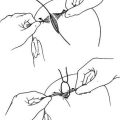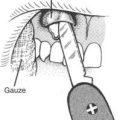GENERAL SYMPTOMS
UNCONSCIOUS (OR SEMICONSCIOUS) VICTIM
As discussed in detail in the section “Major Medical Problems” (see page 21), a proper approach to the unconscious (comatose) victim may make the difference between life and death. You must evaluate the semiconscious (stuporous, dazed, confused, or combative) individual with the same degree of concern. To discover the cause of an altered mental status, you must be a bit of a detective, while also performing the tasks that prevent the victim from hurting himself. Always assume that an unconscious person may be seriously injured.
1. Open and maintain the airway (see page 22). Check for adequacy of the pulse (see page 33).
2. Protect the cervical spine (see page 37). Every injured person has a broken neck until proven otherwise.
3. Carefully examine the victim for evidence of an obvious injury and treat accordingly.
4. Consider low blood sugar, and treat the victim with glucose if he is alert enough to cooperate (see page 142). If not, and glucagon for injection is available, consider its use (see page 143).
1. Don’t shake a victim vigorously to awaken him without first protecting the neck. Never shake a victim to awaken him if you suspect that hypothermia (see page 305) is present. If you think that the victim is merely intoxicated, you may snap an ammonia inhalant or hold “smelling salts” under his nose, and allow him a few whiffs to stimulate awakening. If there is any chance of a neck injury, do not perform this maneuver without maintaining the head and neck in a stable position.
2. Don’t attempt to carry an unconscious victim or manage a belligerent person if this might exhaust you. Send someone for help and stay with the victim until help arrives.
3. Unless there is no other way to get lifesaving help, never leave an unconscious or dazed person unattended.
FAINTING
Fainting is defined as sudden brief loss of consciousness not associated with a head injury. There are innumerable causes of fainting, but most episodes are associated with decreased blood flow (oxygen and/or glucose) to the brain. This may be caused by low blood sugar (hypoglycemia—see page 142), slow heart rate (vagal reaction, in which the vagus nerve, which slows the heart rate, is overstimulated: fright, anxiety, stomach irritation, bowel dilation, drugs, fatigue, prolonged standing in one position), rhythm disturbances of the heart, dehydration, heat exhaustion, anemia, or bleeding.
After a victim suffers a fainting episode, he should be examined for any sign of serious illness or injury. If you don’t suspect anything serious, have him lie still for a few minutes, and then sit for a few minutes. If the victim is alert and capable of purposeful swallowing, offer him cool sweetened liquids to drink—preferably one that contains electrolytes (see page 208)’to correct dehydration. When the victim feels normal, he may slowly regain an upright posture. If the victim is elderly, and particularly if his pulse is irregular or he has chest discomfort, seek immediate medical assistance. Anticipate a heart attack (see page 50).
FATIGUE
Fatigue (lethargy, tiredness, exhaustion, generalized weakness, decreasing exercise tolerance) can be a sign of any disorder or dysfunction that diminishes a person’s energy level. Accompanied by fever, it can be indicative of an infection; accompanied by certain associated symptoms, it may indicate a hypoactive thyroid. In the outdoors, anyone who began the trip in good condition but is now fatigued should be examined carefully for signs and symptoms of hypothermia (see page 305), hyperthermia (see page 322), high-altitude illness (see page 335), infection, mental depression (see page 301), anemia (pale membranes inside the eyelid, pale fingernail beds, sallow skin complexion), dehydration (see page 207), or starvation. A diabetic who becomes fatigued may suffer from high or low blood sugar (see page 142). If fatigue is accompanied by shortness of breath, do not travel any farther from civilization until you determine a treatable cause, or the victim clearly improves. Sudden onset of fatigue can be indicative of a heart attack (see page 50).
In a situation of extreme exercise within a particular muscle group—the legs during forced or military-style marching, or long-distance or marathon running; the arms during repetitive, relentless exertion such as weight lifting—muscle tissue can be broken down. This is more common under conditions of environmental heat (see page 322). Substances (particularly myoglobin, a pigment that carries oxygen) are released into the bloodstream, which in large concentrations can cause the kidneys to fail. The victim has very darkened (brown) urine (myoglobinuria), sore muscles, and extreme fatigue. In this situation, remove the victim from environmental heat, place him at as near complete rest as possible, and encourage him to drink as much liquid as he can to correct dehydration and flush the pigment from his system (see page 208).
FEVER AND CHILLS
Normal body temperature is 98.6°F (37°C) measured orally, and 99.6°F (37.5°C) measured rectally. To convert degrees Fahrenheit (F) into degrees Centigrade (C, or Celsius), subtract 32, then multiply by 5, then divide by 9. To convert degrees C into degrees F, multiply by 9, then divide by 5, then add 32. A temperature conversion chart is found on page 509.
Temperature should be measured with a thermometer. Electric (digital) thermometers are easiest to use and require the least time to record a temperature. If you use a mercury or alcohol thermometer, first shake it to pool the mercury or alcohol below the 94°F (35°C) marking. If you suspect the victim to be hypothermic, a special thermometer is necessary (see page 305). To take a temperature by mouth, place the thermometer under the tongue, close the mouth, and take a reading after 3 to 4 minutes. To take a temperature rectally (the more reliable method, and necessary in a case of suspected hypothermia), the thermometer is gently placed—ideally lubricated with oil or petroleum jelly—1 in (2.5 cm) into the rectum. It is held for at least 2 minutes and then read. Never leave a child or confused adult unattended with a thermometer in the mouth or rectum. Do not rely on skin temperature to vary consistently with changes in core body temperature.
Generally, an infection will not elevate the core (rectal) body temperature higher than 105°F (40.5°C). Anyone with a temperature measured above that level should be examined for heat illness (see page 322), stroke (see page 144), or drug overdose. Vigorous prolonged muscular activity (seizure or marathon running) can raise the core temperature above 107°F (41.7°C).
A child is considered to have a fever if his rectal temperature is greater than 100.4°F (38°C), oral temperature is greater than 100°F (37.8°C), or armpit temperature is greater than 99°F (37.2°C). You should be concerned about a fever greater than 100.4°F (38°C) in an infant less than 3 months of age or greater than 104°F (40°C) in any small child, because this can indicate a severe infection. If a child greater than 2 years of age has a fever greater than or equal to 106°F (41.1°C), and if there is no clear diagnosis of a viral infection, he should be treated with a broad-spectrum antibiotic (e.g., amoxicillin-clavulanate), on the rationale that there is a significant likelihood of a bacterial infection. Prolonged fever in a child should be investigated by a physician. Signs of a serious infection in an infant include lethargy (“floppy baby”), pain (persistent crying), labored breathing, purple skin rash, excessive drooling, a bulging “soft spot” (fontanel) on the top of the head, or a stiff neck.
If the victim suffers from environmental heat-induced illness (see page 322), he will not benefit from and should not be given aspirin or acetaminophen. Ibuprofen is not as dangerous but is also not helpful.
FEVER IN A RETURNED TRAVELER
• Less than 10 days: influenza, dengue, yellow fever, plague, paratyphoid fever, Mediterranean spotted fever, African tick-bite fever, Rocky Mountain spotted fever
• 10 to 21 days: malaria, viral hemorrhagic fevers, typhoid fever, scrub typhus, Q fever, relapsing fever caused by Borrelia organisms, African trypanosomiasis
• More than 21 days: malaria, filariasis, brucellosis, hepatitis (A, B, C, E), rabies, schistosomiasis, leismaniasis, amoebic liver abscess, tuberculosis
COUGH
Cough is a common symptom. It is commonly associated with an upper respiratory infection, but can also be due to throat irritation, drug side effect, sinusitis, bronchitis (see page 205), serious infectious disease (e.g., pneumonia—see page 48), asthma (see page), heart failure (fluid in the lungs—see page 47), reflux esophagitis (“heartburn”—see page 221), allergy, or high-altitude pulmonary edema (see page 340).
Whooping cough (pertussis) is a highly communicable infectious disease caused by the bacterium Bordetella pertussis. It is transmitted by respiratory secretions or large droplets from the respiratory tract of an infected person. In children, whooping cough is typified by coughing episodes that are sudden, intense, and sometimes accompanied by vomiting and inspiratory “whoops,” indicating throat spasms on inhalation. It is not uncommon for the victim to cough in severe spells and to have gagging or vomiting after a coughing spell. In adults, it most commonly presents like a common cold for a week or two (this is the most infectious period), followed by a mild cough that becomes progressively severe. The cough is as described in children and may also involve difficulty breathing. Untreated, the cough may last for 6 to 10 weeks in children and for more than 10 weeks in adults. If this diagnosis is made, the victim should be treated with azithromycin (10 mg/kg of body weight [not to exceed 250 mg] by mouth once a day on day 1, then 5 mg/kg on days 2 through 5 for children; 500 mg day 1, then 250 mg days 2 through 5 for adults); erythromycin (40 to 50 mg/kg per day in 4 divided doses [not to exceed 2 g per day] for 14 days for children; 500 mg 4 times a day for 14 days for adults); clarithromycin (15 mg/kg per day in 2 divided does [not to exceed 1 g per day] for 7 days for children; 500 mg twice a day for 7 days for adults); or with trimethoprim-sulfamethoxazole (8 mg/40 mg per kilogram per day in 2 divided doses for 14 days for children; 160 mg/800 mg twice daily for 14 days for adults). The protective effect of DTaP (diphtheria-tetanus-pertussis) vaccine wanes rapidly 3 to 4 years after the last dose, so adults remain vulnerable to the disease.
COUGHING BLOOD
Sore Throat
The victim will complain of an irritated throat and difficulty swallowing, and will cough up whitish phlegm streaked with blood. If the victim is not short of breath and is not in distress, rapid medical attention is not necessary (see page 46). Similarly, if a person has a nosebleed, he may cough and spit a lot of blood (see page 192).
Pneumonia
The victim will complain of fever, chills, chest pain, and shortness of breath. He will cough up green or rust-colored thick sputum (see page 48).
Pulmonary Embolism
The victim will complain of difficult and painful breathing, shortness of breath, agitation, and weakness. Generally, only severely ill persons will cough up small clots of blood (see page 46).
Lung Cancer
The victim will suddenly cough up small pieces of spongy lung tissue or tumor, along with blood clots. Attend to the airway (see page 22) and seek medical attention.
Lung Injury
If a victim is struck in the chest, and particularly if his ribs are broken, the underlying lung can be bruised or torn. The victim will cough up small clots of blood or, if the injury is major, mouthfuls of blood. This is extremely serious and requires constant attention to the airway (see pages 22 and 42).
DIZZINESS
Dizziness is a feeling of lightheadedness, with or without a sensation of spinning (vertigo). It often precedes a fainting episode (see page 165) or may accompany a stroke (see page 144), heart attack (see page 50), low blood sugar (see page 142), heat illness (see page 322), ear infection (see page 175), the bends (see page 403), plant poisoning (see page 416), motion sickness (see page 440), and many other disorders. Frequently, dizziness is caused by an infection or disorder of the middle ear, which controls balance. Indeed, if the external ear canals are blocked by wax, this alone can cause dizziness.
If a victim is dizzy, he should lie on his back and attempt to regain orientation to his surroundings. Examine him for obvious causes and treat accordingly. If the dizziness does not resolve, and particularly if the victim is elderly (in which case it might indicate a stroke), he should be taken to a physician. True vertigo is very distressing to the victim and described by him as “the room spinning around,” with nausea and/or vomiting, weakness, ringing in the ears (tinnitus), and occasional slow jerking or fluttering movements of the eyeballs (nystagmus). Benign sudden positional vertigo may be caused by free-floating calcium carbonate crystals in the inner ear. Inflammation of the inner ear (often associated with a recent cold) is known as vestibular neuronitis (“labyrinthitis”). It is treated with the same medications used for motion sickness (see page 440). In addition, a 3-week taper of a corticosteroid (such as methylprednisolone) in a starting dose similar to that for a severe poison oak rash (see page 232) may hasten recovery. Antiviral agents have not been proven effective for this condition. The benzodiazepine class of drugs (including lorazepam or clonazepam 0.5 mg by mouth twice a day, or diazepam 2 to 5 mg by mouth every 6 hours as needed) may be useful to suppress vertigo, but carry the side effect of sedation. Vestibular neuronitis is a diagnosis to be reached by a physician after more serious problems are excluded.





